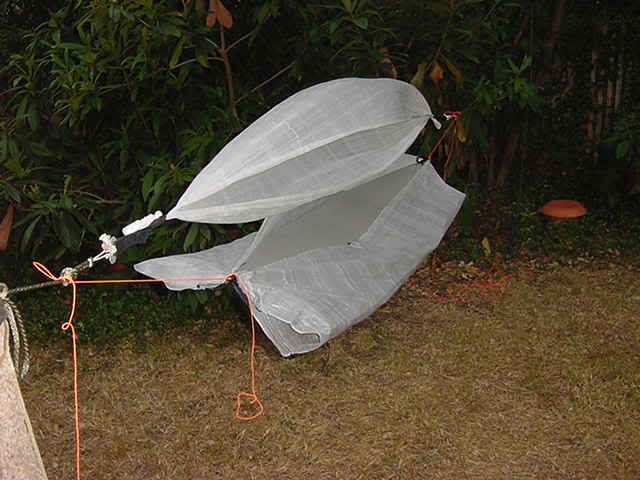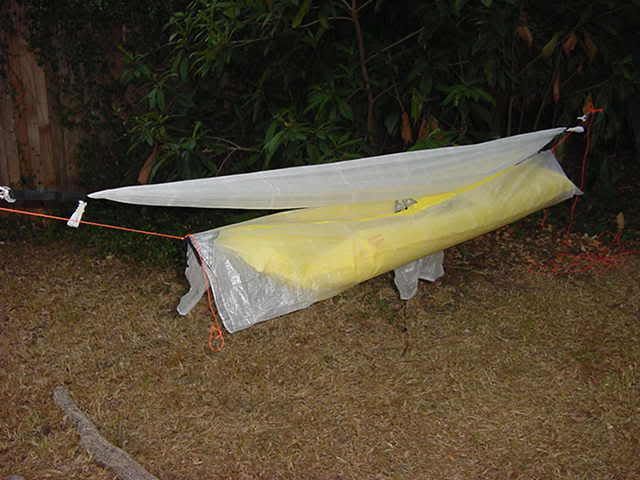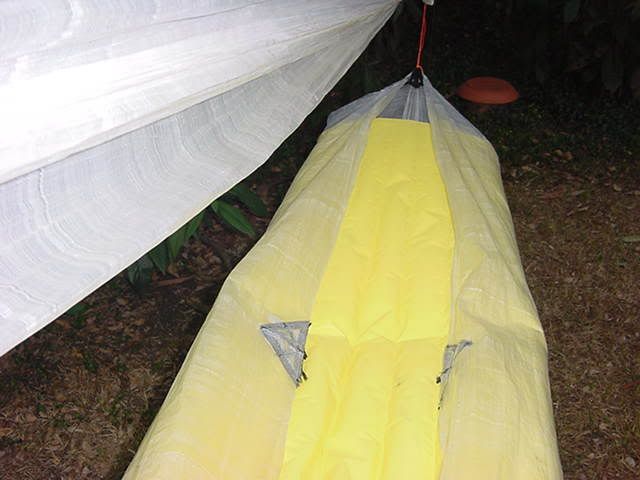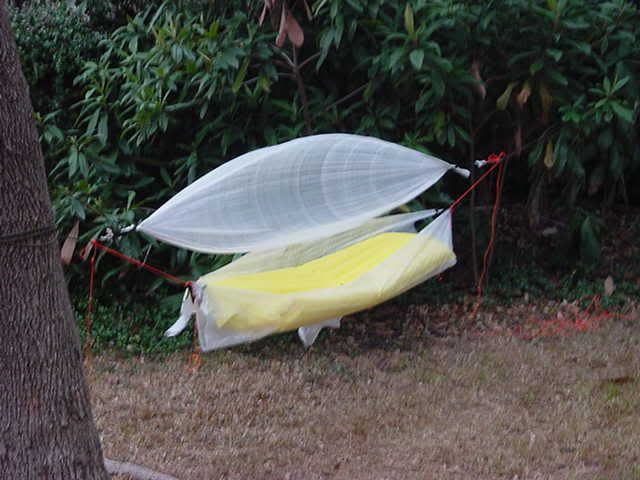Topic
Needed: High R-Value Inflatable Bottom Insulation for Hammocks
Forum Posting
A Membership is required to post in the forums. Login or become a member to post in the member forums!
Home › Forums › General Forums › Hammock Camping › Needed: High R-Value Inflatable Bottom Insulation for Hammocks
- This topic is empty.
-
AuthorPosts
-
Sep 10, 2011 at 5:17 pm #1279189
I would love to see an inflatable high R-value bottom insulation system for hammocks. It seems that it would be easy to make, as the fabrics could be extremely light– they only need to support their own weight while suspending the internal insulation and blocking wind and convection losses. A hammock air pad would need to be fairly deep (thick), wide and flexible– say 42" wide x 60"-72" long, and loose enough to curve end to end and sideways at the same time. The 4.9 R-value reached by the Neo Air All-Season would be great. The outer shell could be extremely light, as it would never need to support the users weight. It could be something on the order of a mylar balloon, provided it can "deploy" the insulation and not transfer thermal energy. I am imagining something shaped like a flat bottom boat or tub with up-swept ends.
Sep 10, 2011 at 7:30 pm #1778279Tim Marshall already makes an inflatable cuben fiber quilt, and I bet an underquilt would be doable.
Sep 10, 2011 at 8:29 pm #1778293An underquilt should be easy. Any contacts for Tim Marshall?
Sep 10, 2011 at 9:44 pm #1778309why not check out the cuben fiber / nylon hybrid 3/4 underquilt at hammock gear
Sep 10, 2011 at 10:28 pm #1778317Underquilts strike me as the most cobbled together equipment I have ever seen. The Achilles heel of hammocks is bottom insulation and I think it can be done better. Having partial insulation leaving you feet and/or head exposed and the possibility of slipping around and leaving you cold in the middle of the night is poor design. It gets to be a mess of strings and shock cords that makes me crazy.
There is no reason that insulation can't be better incorporated into hammocks. Clark is the only manufacturer I have seen that recognizes the neccessity of bottom insulation for any hammock being used in North America and made it an integral part of the design. All the rest have bits and peices thrown together to make it work. Hennessy has come close with the SuperShelter, but it still looks like an afterthought and has a plethora of strings and clips and gizmos to tack it together.
Sep 11, 2011 at 7:26 am #1778384"It gets to be a mess of strings and shock cords that makes me crazy. "
We have a different experience with hammock insulation. I have a single shock cord, with a small carabiner at each end of the cord, at each end of my hammock (JRB system). The carabiners attach to loops sewn onto my underquilt. No strings. I use a full-length under quilt – not a fan of the 3/4 under quilts. My under quilt is cuben/down made by Tim Marshall (as are all my quilts, under and over). I've never had it slip anywhere – never had it leave me cold (including the trip where I hammocked down to 3 degrees). It takes me all of 2-3 minutes to attach the under quilt to the hammock.
I like not having the insulation integrated because I have different insulation needs for different temps – the mix and match method works very well for me, and has never failed. FWIW.
Sep 11, 2011 at 7:26 am #1778385I agree that there could be some improvements (i.e. a breathable light weight aerogel pad that covers the entire hammock). However, I can assure you having tried several different pads and quilts that the 3/4 is a solid choice. I thought my head / feet would be cold too but not really. Last year we were up on a ridge in November with crazy wind, temps were around 25 before windchill (water bottle froze solid by 8). I had my UQ, pants in a stuff sack under my feet, and my fleece pillow with my socks / camp towel in it, and I was great (hammock was a DL WBB). You could always go for the full length jacks r better no snivler, you can offset the weight by wearing the quilt as an insulation layer around camp. I think (could be wrong) that the 3 season hammock gear cuben quilt is around 10 oz? That's hard to beat, even with a pad.
Sep 11, 2011 at 7:29 am #1778388"Tim Marshall already makes an inflatable cuben fiber quilt"
This can be slightly misleading. Tim's quilts don't 'inflate' like an air pad, you add air to allow the down to loft. It feels and acts like a 'normal' quilt, not like an air mattress.
Sep 11, 2011 at 7:52 am #1778396I am not making quilts right now anyways. I am trying to hire a small staff so we can get going again but it is proving harder than expected. Doug you know my quilts want to start making them?
As an underquilt my "inflatable" quilt could have much more air pumped into it than when used in topquilt mode (too stiff as a TQ and it won't drape right) but it isn't airtight and some air will leak in/out over time. however since your weight isn't on it you will still find it to keep a lot of the loft you put in there. I have inflated quilts baffled to 2" to over 5" and left them over time and they hadn't lost significant loft. However they were too stiff to use on top. on the bottom i suspect it would lose loft where it is compressed by the hammock but then stop loosing loft. and it would never loft lower than it was baffled and filled to loft (1.5", 2.25" or 3" as of right now) Needless to say a cuben UQ is on my personal to do list.
-Tim
Sep 11, 2011 at 10:14 am #1778435Thanks for replying, Tim.
An inflated underquilt would need to be rather slack and very much a differential/shaped cut. My though it is that it should be synthetic fill like current air pads and incorporate a reflective surface on the hammock side. It could be far lighter fabric than any air mattress and should be full length. If Therm-a-rest can get R4.9 out of a 2.5" think pad, a 3"-4" pad with a similar R-value should be approachable by a cottage manufacturer. The inflation would be just enough to get full loft and it is hanging down, so gravity would aid the process where it deters it on a top quilt. All suspension/stress should be on the top/hammock surface.
If a full-length suspension layer is used, the last 12" or so on each end could be just fabric to provide wind blocking and simplify the suspension. The sides could have Velcro, snaps, or zippers to hold them to the hammock. The resulting space between could be used to add more insulation, like Insultex or Thinsulate.
I think making universalized components as the end project would be a mistake. To eliminate the Rube Goldberg arrangements and reduce weight, the hammock and insulation must be designed as a tightly integrated system. The current state of the market is a little like selling poled tents and leaving the buyer to go get a rainfly that kind of fits. Fortunately, the topside insulation and the tarp designs can be much more universal yet remain light and effective.
I've also thought of making a hammock that has a deep outer pocket with crosswise drawstrings to control the space and insulated pads could be made to go inside. The pocket would have Velcro or zippered access on each side and some means of attaching the pad to suspend it. The stress would all be on the hammock bottom. Insulation could be down, synthetic fill, reflective/space blanket material, or any combination. My preference would be to use a space blanket in conjunction with synthetic filled pads. The outer covers on the pads could be the lightest material available, as they would only need to protect the insulation for packing and laundering.
This is really just taking the Garlington Insulator undercover-and-insulation concept and integrating into the hammock rather than a separate item. Clark accomplishes the same thing by adding a series of pockets down the side of the hammock. Six pads and end insulators make up their Z-liner insulation system. See http://www.youtube.com/watch?v=uaGZHrKrK50 for a user-made video showing the Clark Z-liner.
I find it indicative of the market that Clark doesn't tout the need for insulation and you must hunt through their web site to find that they offer the Z-liner kit– it is buried in the online order page. The Z-liner kit nor the need for insulation is not mentioned in the specs and description for the North American model, which only describes the "insulating pockets."
I don't know of any hammock manufacturer's web page that tells the prospective buyer that a hammock is useless for sleeping in sub-70F weather without some form of bottom insulation. Take a major retailer like REI, where you will find several makes and models of hammocks, but there is nothing mentioned or even offered for bottom insulation. I'm sure it is an oversight rather than some dastardly marketing plot to rope in the buyer. For example, you can drop $150 for a Hennessy Explorer which appears to be a nicely coordinated system, only to find that your 20" ground pad is uncomfortable and not wide enough and you need to add a $130 SuperShelter which weighs a full pound and adds much complexity to the setup. You won't find that mentioned on the web site– you need to discover it yourself by trial and error, or find in mentioned in a forum. Once you know to look for insulation components, then you will find the product and video links. I don't aim to pick on Hennessy exclusively, as ALL the cottage and factory manufacturers are guilty of the same.
We are looking at a whole outdoor equipment category that is relatively young and in a constant state of development. I would liken it to the development of external frame packs where things kept getting bigger and heavier until there were design and consumer revolts.
Sep 11, 2011 at 10:25 am #1778437From one of my threads here back in Jan 2009:
=======
Winterizing My Cuben Fiber Hammock.
I am working on a way to extend the use of my Cuben Fiber Hammock down to a low temperature such as 20 or so F.
I have always used a sleeping pad or my Stephensons Warmlight Down Air Mattress (DAM) inside my Hammock when I need more insulation to keep my backside warm. When I made my Cuben Fiber Hammock I had less room inside the Cuben Hammock then I did in my Silk Hammock.
Paul, I friend of mine and Hammock Hanger had talked a lot about double bottom Hammocks. I didn't want to use another large piece of my Cuben Fiber just for a double bottom. This afternoon I had an idea, why not tie my Cuben Poncho/ Tarp under my Hammock. I have to make another larger Tarp so I could multi-use the Poncho / Tarp when necessary.
The following pictures tell the rest. The temperature while I was doing this was 38 degrees F with a nice wind blowing. I have to say I am pleased so far with how this has turned out. To test the setup I got into the Hammock. My weight presses me into the Down Air Mattress. The longer a was in the Hammock the warmer my back got. The Poncho/Tarp edges fold over some and encase the Down Air Mattress holding it in place.
How much does all this weigh:
Cuben Hammock Hanging – 6.65 ounces
Double Bottom – Cuben Poncho / Tarp – 2.8 ounces.
Warmlight Down Air Mattress – 24.53 ounces.
Inflate Bag – 2.8 ounces.Total weight: 36.78 ounces
I am not real happy about the weight of the DAM but I have used it for several years and trust it down to near 0 degrees on the ground.
I will be working on what I use for top insulation over the next few days. I may be able to make back some of the weight I gave up for the DAM.
1.

2.

3.

4.

5.

The timer on my camera is to short to for me to get into the hammock. My body weight lets me settle down into the DAM. Since I did this I have made an "under" quilt of sorts using 5 to 6 inches of XP that I think gives me the same warmth with a lot less weight. I use it with my modified – Army Jungle Hammock – also not as light as I would like, but very comfortable to sleep in. The Army Jungle Hammock uses a spreader bar that lets me sleep flat.
Sep 11, 2011 at 10:56 am #1778453Hi Bill!
I did the same, designing a hoodless silnylon poncho as an undercover and tried it with a POE insulated air mattress, which is too narrow and too heavy, but it was a successful experiment— where there was insulation, it was warm.
What is needed is something more on the order of your balloon mattress concept, but with insulated air chambers. Weight bearing properties are simply not needed. I have thought seriously about having a big insulated air mattress made of mylar and shaped to work with a hammock. If you design something like a 6" thick mattress and under-inflate it, it should form to the right shape. It is a debate on whether to support that mattress with an undercover, design a suspension system into it, or incorporate it into the hammock body. If you like ponchos, the undercover is an easy multiple-use compromise; otherwise, I would vote for an integrated pocket in the hammock.
I do think there are a couple orders of magnitude with hammock insulation too, with 3-season and 4-season demanding different designs. There are some who have camped at -26F comfortably with high loft top and under quilts and top covers and a good dose of warm clothing. I would be happy with a system that is good to to an honest 20F. The 20F range is a whole different cookie for design, weight and cost than a -26F system. Even 32F coverage would take care of the majority of my needs.
Poncho undercover with Hennessy Expedition Zip:

This is a space blanket insulator with a polyester fill. It simply sits in the undercover. This is a variation on the Garlington Insulator concept.

This is an all-space blanket Garlington Insulator before taping the final side. Garlington's take was to use light trash bags with crumpled space blankets inside to provide insulation layers and cut convection currents.

-
AuthorPosts
- You must be logged in to reply to this topic.
Forum Posting
A Membership is required to post in the forums. Login or become a member to post in the member forums!
Trail Days Online! 2025 is this week:
Thursday, February 27 through Saturday, March 1 - Registration is Free.
Our Community Posts are Moderated
Backpacking Light community posts are moderated and here to foster helpful and positive discussions about lightweight backpacking. Please be mindful of our values and boundaries and review our Community Guidelines prior to posting.
Get the Newsletter
Gear Research & Discovery Tools
- Browse our curated Gear Shop
- See the latest Gear Deals and Sales
- Our Recommendations
- Search for Gear on Sale with the Gear Finder
- Used Gear Swap
- Member Gear Reviews and BPL Gear Review Articles
- Browse by Gear Type or Brand.











